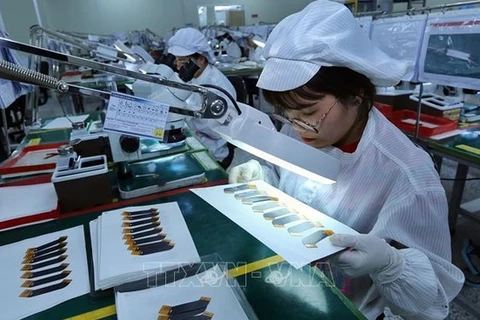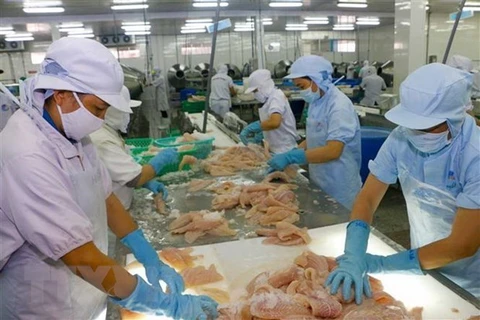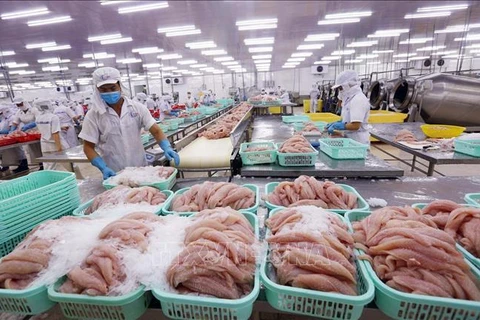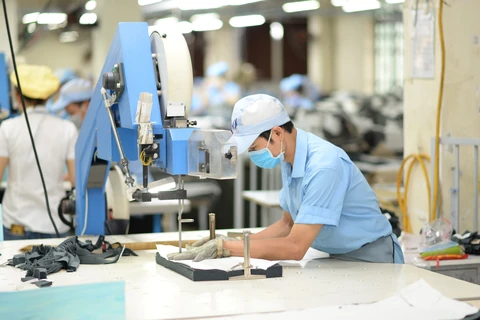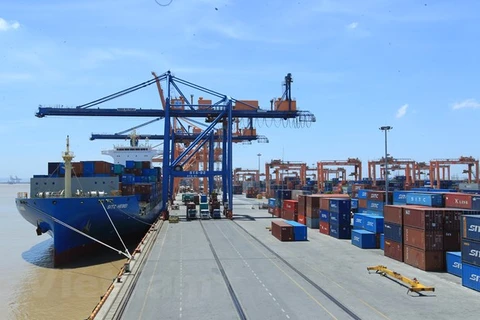 Vietnam's export turnover in the first half of 2021 increased by 32.2 percent year-on-year (Photo: VNA)
Vietnam's export turnover in the first half of 2021 increased by 32.2 percent year-on-year (Photo: VNA) Hanoi (VNA) – There is a great opportunity for Vietnam to promote its exports as global markets are showing signs of recovery, experts have said.
Vietnam's total import-export revenue hit over 316.7 billion USD in the first six months of 2021, representing a staggering year-on-year increase of 32.2 percent, despite complicated developments of the COVID-19 pandemic.
Experts have predicted that Vietnam’s import-export turnover is likely to enjoy positive results in 2021.
Growth led by processing industry
Vietnam’s export turnover reached 57.63 billion USD in the first six months of 2021, up 28.4 percent year-on-year, according to the Ministry of Industry and Trade.
Notably, the manufacturing-processing sector raked in 135.5 billion USD, up 31.3 percent from the same period last year and accounted for 85.9 percent of total exports.
Most of the key products the sector produces such as phones, electronic products, computers, machinery and all related components, equipment and spare parts, contributed significantly to improve overall export value.
According to the Director of the Department for General Economic Studies of the Central Institute for Economic Management (CIEM) Nguyen Anh Duong, global and regional economies are recording post-pandemic recoveries.
The US and EU - the major export markets for Vietnam, seem to have the pandemic under relative control.
China – another big market for Vietnam, has also seen recovery.
These are the external factors that can help Vietnam further boost its exports in the coming months, Duong stressed.
In the first six months of 2021, Vietnam's exports to the US and China expanded by 43.3 percent and 25.1 percent, respectively.
Recently, large smartphone producers such as Apple and Samsung have forecast a large increase in smartphone sales for the last six months of the year.
Vietnam needs to take advantage of this opportunity as this is an area in which the country’s manufacturing sector has strength and experience, Duong noted.
Trade deficit not a concern
Statistics from the Ministry of Industry and Trade show that Vietnam experienced a trade deficit of 1.47 billion USD between Jan – June this year. In contrast, the country enjoyed a trade surplus of 5.86 billion USD during the same period last year.
However, experts said that this trade deficit is not unusual.
Duong said Vietnam mainly imported materials for the production of goods for export.
Deputy Director of the Import-Export Department under the Ministry of Industry and Trade Tran Thanh Hai, said some industries such as textiles, footwear, and furniture have imported raw materials to serve their production needs for the remaining months of the year, resulting in the increased volume of imported materials.
The prices of raw materials on the world market have fluctuated dramatically in recent times, pushing up the cost of imports, he added.
Hai said he believes that Vietnam can maintain a trade surplus in the near future.
Regarding export prospects for the second half of the year, Hai made many positive forecasts, noting that factories in Bac Ninh and Bac Giang have restored production to usual levels.
He also mentioned positive signals in the agricultural sector as Vietnamese businesses have fully tapped opportunities brought by next-generation free trade agreements, such as the EU-Vietnam Free Trade Agreement (EVFTA) and the Comprehensive and Progressive Agreement for Trans-Pacific Partnership (CPTPP), to promote the export of Vietnamese farm produce to the world.
Local firms have successfully exported lychees through e-commerce platforms, opening up opportunities for many other agricultural products, Hai said.
Meanwhile, economic expert Nguyen Minh Phong emphasized the importance of taking advantage of the new generation of FTAs, especially CPTPP, EVFTA and the Regional Comprehensive Economic Partnership (RCEP) agreement, and publicly announcing tax reduction roadmaps and incentives related to the new FTAs. This should further Vietnam’s export and trade activities/.
